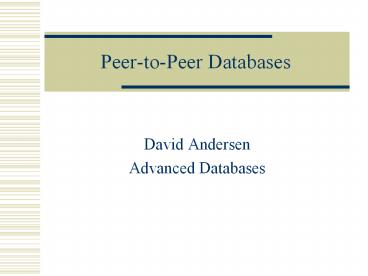Peer-to-Peer Databases - PowerPoint PPT Presentation
1 / 21
Title:
Peer-to-Peer Databases
Description:
Peer-to-Peer Databases David Andersen Advanced Databases What is Peer-to-Peer? Shared Resources Each peer is a shares its resources with others, acting as both a ... – PowerPoint PPT presentation
Number of Views:146
Avg rating:3.0/5.0
Title: Peer-to-Peer Databases
1
Peer-to-Peer Databases
- David Andersen
- Advanced Databases
2
What is Peer-to-Peer?
- Shared Resources
- Each peer is a shares its resources with
others, acting as both a client and server. - Decentralization and Self-organization
- Peers coordinate their activities with other
peers rather than with a centralized server. - Autonomy
- Peers are free to come and go at will.
3
Napster
- Hybrid P2P
- Data stored on peers, but a central server
maintained index of file location. - File sharing - not a DBMS system.
4
Gnutella
- True P2P - Peer need only know one other peer to
join. - The Gnutella Protocol
5
Gnutella
- Uses Flooding
- Queries hop from peer-to-peer. A TTL
(time-to-live) sent with the query prevents
eternal searching. - Very High Bandwidth Usage.
- File Sharing Not DBMS
6
P2P and Databases
- Advantages
- No Bottlenecks
- Vast Resources Available
- Improved Scalability
- Improved Robustness
- Less Management
- Access to a tremendous amount of data
7
P2P and Databases
- Challenges
- Coordinating Semantics
- Query Processing Efficiency
- Topology/Bandwidth Considerations
- Indexing
- Replication
- Performing Updates and Avoiding Stale Data
- Security - Access Control and Peer Reputation
8
Case Study Hyperion Project
- Peers have a own local DBMS.
- PeerDBMS layer augments the local DBMS to support
peer-to-peer functionality. - Peers can form acquaintances.
- Metadata is exchanged and the semantics of the
peer acquaintance is mapped on the local system. - Uses Pair-wise Mappings to resolve queries.
9
The Hyperion PDBMS
- Query Service
- Handles Local Queries
- Uses Mapping Tables to Rewrite or Translate
Queries destined for Remote Databases - Peer Coordination Service
- Manages and Executes Updates
- Uses Event-Condition-Action Rules
10
The Hyperion PDBMS
- P2P User Interface
- Local and Peer Queries are posed through the
interface - User is unaware of differing semantics at the
peer - Peer Manager
- Messaging system to communicate with peers
- Acquaintance Manager
- Manages exchange of schemas, mapping tables, and
rules for updating data
11
Hyperion Mapping Tables
- Table from Airline A
- Table from Airline B
- Mapping Tables
12
Case Study The Piazza Project
- Project Goals
- Focus on developing query reformulation
algorithms - Assist in defining mappings
- Indexing
- Enforcing access control
13
Piazza Schema Mappings
- Two types of mappings
- Peer Description
- Relates two or more peer schemas
- Example DBProjectsMember(pName, member)
- UWMember(mid, pid, member), UWProject(pid,
pName) - Storage Description
- Relates data stored in at a peer into peers view
of the world. - ExampleUPennstudent(sid, name, advisor)
UPennStudent(sid, name), - UPennAdvisor(sid, fid), UPennFaculty(fid,
advisor)
14
Piazza Querying Reformulation Example
15
Piazza Indexing
- Challenge
- How to send a query to a peer most likely to
have the answer and avoid flooding entire
network. - Piazza attempts to index schema and value
mappings. - Current implementation is centralized
- Peers upload summaries of differing granularity
of data they possess - Peers periodically refresh their data summaries
at the index.
16
Piazza Indexing
- Peers upload attribute value pairs.
- Index maintains a table of these pairs together
with the object id of its origin. - Users query to the index and are returned the
object which contains at least a partial match. - An example of an object that is indexed
- s2 name "Por", age IN 50, 70,
- disease "tuberculosis", type ""
17
Update Management
- Data is often replicated with traditional
distributed databases - Problem is to avoid reading stale data
- Technique Use Read Consensus and Write
Consensus - Example Write to majority before performing
update and/or read to a majority and accept
newest version.
18
Update Management
- Quorum Consensus can work with P2P too, but not
with 100 guarantee because actual number of
replications is not known, so setting a quorum
very difficult. - Allow user to set quorum thresholds and accept
the consequences of their decisions.
19
Update Management
- Trade-offs
20
Questions?
21
References
- Flexible Update Management in Peer-to-Peer
Database Systems,David Del Vecchio and Sang H.
Son, Department of Computer Science, University
of Virginia - An Overview on Peer-to-Peer Information Systems,
Karl Aberer, Manfred Hauswirth, Swiss Federal
Institute of Technology (EPFL), Switzerland - Data Sharing in the Hyperion Peer Database
System, Patricia Rodríguez-Gianolli et al,
Proceedings of the 31st VLDB Conference,Trondheim,
Norway, 2005 - The Hyperion ProjectFrom Data Integration to
Data Coordination, Marcelo Arenas et al, SIGMOD
Record, Vol. 32, No. 3, September 2003 - The Piazza Peer Data Management Project, Igor
Tatarinov et al, SIGMOD Record, Vol. 32, No. 3,
September 2003 - Distributed Query Processing in P2P Systems with
incomplete schema information, - Marcel Karnstedt, Katja Hose, Kai-Uwe Sattler,
Department of Computer Science and Automation, TU
Ilmenau P.O. Box 100565, D-98684 Ilmenau, Germany































